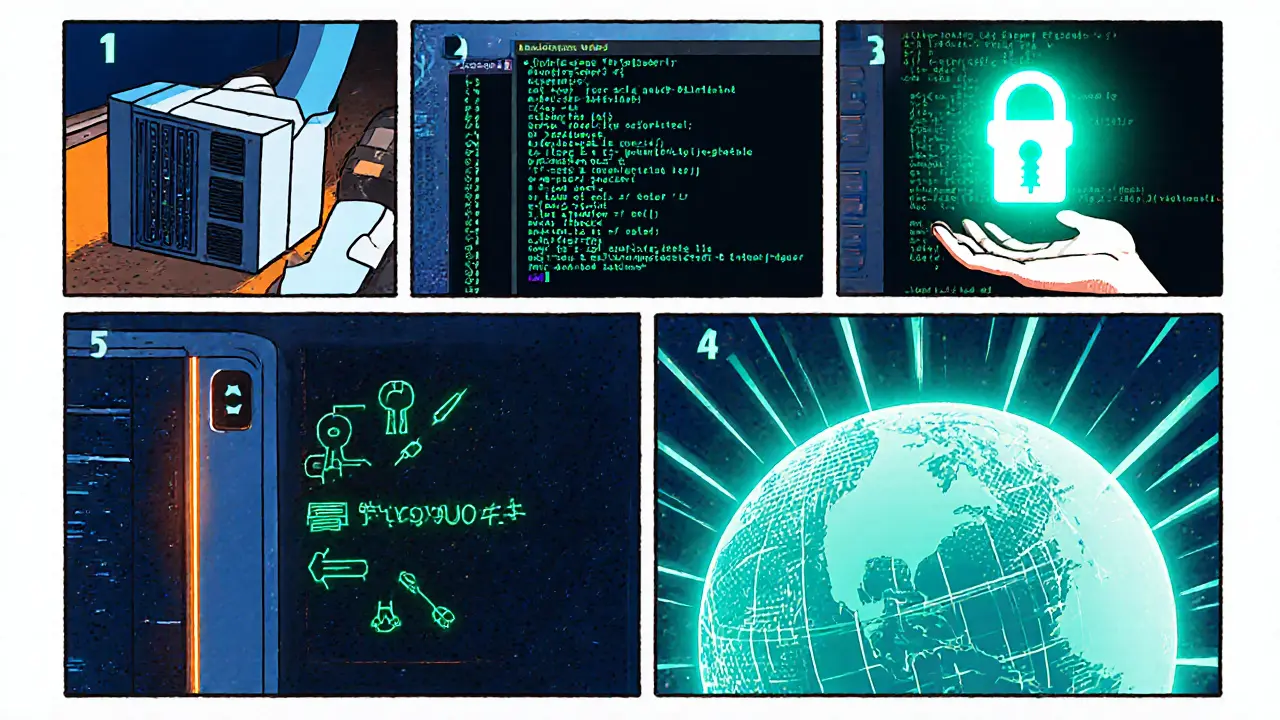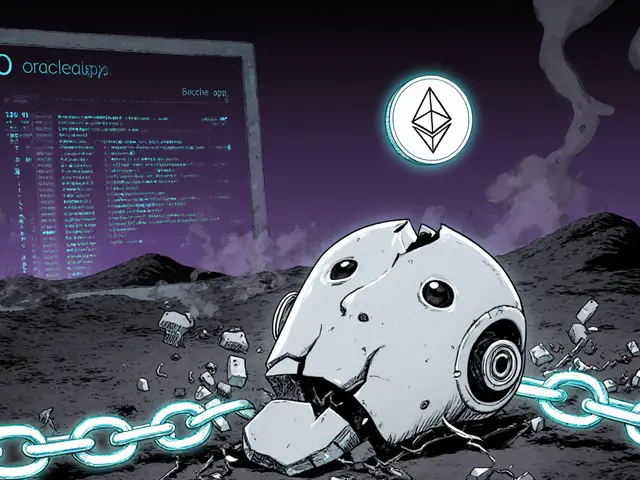Validator Node Setup Checker
This tool helps you determine if your hardware meets the minimum requirements for running a validator node on a Proof-of-Stake blockchain. Enter your system specs below to get started.
Validation Eligibility Report
Your Configuration
- CPU Cores $CPU_CORES$
- RAM $RAM_GB$ GB
- Storage $STORAGE_TYPE$
- Uptime $UPTIME_PERCENT$%
Network Requirements
- Minimum Stake 32 ETH
- Recommended CPU 2 cores
- Recommended RAM 8 GB
- Storage Type SSD
Key Takeaways
- Validator nodes are the security backbone of Proof‑of‑Stake (PoS) blockchains.
- Running a validator requires staking a minimum amount of the native token and staying online.
- Rewards come from block proposals and transaction fees, while misbehavior can lead to slashing.
- Validators differ from miners mainly in energy use, hardware needs, and selection method.
- Liquid‑staking services are lowering the entry barrier for token holders who want to earn validation rewards.
In modern blockchain is a distributed ledger technology that records transactions across a network of computers. The shift from energy‑hungry Proof‑of‑Work (PoW) to more sustainable Proof‑of‑Stake has put validator nodes as specialized participants that verify transactions, propose new blocks, and keep the network honest at the center of the ecosystem.
What Exactly Is a Validator Node?
A validator node is a software instance that stakes the blockchain’s native token, validates incoming transactions, and signs off on new blocks according to the network’s consensus rules. Unlike miners, validators don’t solve puzzles; they’re randomly (or round‑robin) selected from the active set the group of eligible validators that have met the minimum staking requirement to propose or attest to a block.
How Validator Nodes Work - The Four Core Functions
- Transaction validation: Each incoming transaction is checked for a valid cryptographic signature, correct nonce, and compliance with protocol rules.
- Block creation and proposal: Selected validators bundle verified transactions into a block and broadcast it to peers.
- Consensus participation: Other validators cast attestations (votes) on the proposed block. If a super‑majority agrees, the block is finalized.
- Network security contribution: By staking tokens, validators put economic skin in the game, making attacks financially costly.
These steps happen every few seconds on fast networks like Solana, or every 12 seconds on Ethereum’s PoS chain. The speed varies, but the underlying logic stays the same.

Becoming a Validator - Staking, Delegation, and the Active Set
To join the active set, you must meet three basic requirements:
- Stake a sufficient amount of the native token. For Ethereum, the minimum is 32 ETH; for Cardano, it’s a few thousand ADA.
- Run reliable hardware or a cloud instance. A modern multi‑core CPU, 8GB RAM, and a stable broadband connection are enough for most PoS chains.
- Maintain high uptime. Downtime can lead to loss of rewards or, in worst‑case scenarios, slashing the forced forfeiture of a portion of the staked tokens as a penalty for misbehavior or prolonged offline periods.
Many token holders prefer to delegate assign their stake to an existing validator without giving up ownership of the tokens. Delegation boosts a validator’s chance of being chosen while allowing delegators to earn a share of the rewards.
Validator Nodes vs. Miners - Key Differences
| Aspect | Validator Nodes (PoS) | Miners (PoW) |
|---|---|---|
| Energy Consumption | Low - runs on standard servers | High - requires ASICs or GPUs |
| Hardware Needs | CPU, RAM, stable internet | Specialized mining rigs |
| Selection Method | Stake‑based lottery or round‑robin | Hash power competition |
| Reward Source | Block subsidies + transaction fees | Block subsidies + transaction fees |
| Risk of Penalty | Slashing of staked tokens | Hardware wear & electricity costs |
The table shows why PoS validators are seen as more accessible and eco‑friendly. The barrier to entry is mostly capital (the stake) rather than expensive hardware.
Rewards, Risks, and the Economics of Validation
When a validator successfully proposes or attests to a block, the protocol distributes rewards. The exact split varies:
- Base reward: A fixed amount per block, often adjusted for total network stake.
- Transaction fees: Collected from users and handed to the block proposer.
- Delegator share: Validators typically keep a small commission (5‑10%) and pass the rest to delegators.
However, the flip side is slashing. If a validator signs an invalid block, double‑signs, or stays offline for too long, the network can confiscate anywhere from 0.5% to 100% of the staked amount, depending on severity.

Step‑by‑Step Guide to Setting Up a Validator
- Choose a PoS network. Research token economics, staking minimums, and community support.
- Acquire the required stake. Purchase the native token and move it to a secure wallet.
- Prepare hardware. A VPS with at least 2vCPU, 8GB RAM, SSD storage, and 99.9% uptime SLA works for most chains.
- Install the node software. Follow the official validator guide-typically a Docker image or binary release.
- Generate keys. Create a signing key (for block proposals) and an operational key (for node management). Keep the signing key offline when not in use.
- Bond your stake. Submit a staking transaction that locks your tokens in the validator contract.
- Join the active set. After the bond is confirmed, the network may add you to the validator queue.
- Monitor performance. Use tools like Grafana or built‑in dashboards to track uptime, latency, and reward accrual.
- Maintain security. Apply OS patches, enable firewalls, and consider a hardware security module (HSM) for key protection.
Following these steps puts you on the path to becoming a trustworthy validator, and the first rewards usually appear within a few epochs.
Future Outlook - Liquid Staking and Validator Tooling
Liquid‑staking platforms such as Lido or EigenLayer let token holders earn validator rewards without running a node. The staked tokens are wrapped into a liquid token (e.g., stETH) that can be used elsewhere, boosting capital efficiency.
At the same time, third‑party services are building better monitoring dashboards, automated key‑rotation, and slashing insurance products. As the ecosystem matures, we can expect:
- Lower minimum stakes through pooled staking.
- More user‑friendly installers and one‑click deployment scripts.
- Cross‑chain validator frameworks that let a single node serve multiple PoS networks.
All these trends reinforce the central role of validator nodes in securing the next generation of blockchain applications.
Frequently Asked Questions
Do I need technical expertise to run a validator?
Basic Linux command‑line skills are enough for most PoS chains. Many platforms provide step‑by‑step installers, and you can always outsource the operation to a validator service.
What is the minimum stake for Ethereum?
Ethereum requires 32 ETH per validator. Some services let you join a pool with as little as 0.1ETH.
How often can a validator be slashed?
Slashing events are rare and only triggered by serious violations like double‑signing. Most validators never experience a slash.
Can I earn rewards without running a node?
Yes-by delegating your tokens to an existing validator or using a liquid‑staking service.
What hardware specs are recommended for a Solana validator?
Solana recommends at least 12CPU cores, 128GB RAM, and 1TB NVMe SSD to meet performance benchmarks.







Natalie Rawley
January 25, 2025 AT 06:47Okay, let me break it down for everyone because apparently the basics still need a drama‑filled recap. Validator nodes are the new heroes of PoS, stepping in where miners used to sweat it out. They lock up a chunk of the native token, stay online like a diligent night‑watch, and earn rewards without the wasteful GPU farms. If you miss the uptime, the network doesn’t just ignore you – it slashes your stake, which is basically a financial slap on the wrist. The hardware requirements are surprisingly modest: a modest CPU, a decent SSD, and a solid internet connection will get you in the game. So, before you start dreaming of becoming the next crypto mogul, make sure your laptop isn’t a dinosaur and your internet isn’t a dial‑up relic.
Alex Gatti
January 31, 2025 AT 01:40Validators are like the quiet librarians of blockchain, keeping everything in order.
Twinkle Shop
February 7, 2025 AT 00:20Delving into the operational topology of validator nodes reveals a confluence of distributed consensus algorithms, cryptographic primitives, and stochastic selection mechanisms that collectively underpin the security assumptions of modern PoS ecosystems. First, the node must maintain a full or partial copy of the state machine, synchronizing blocks via gossip protocols that ensure eventual consistency across the peer‑to‑peer overlay. Second, the staking smart contract enforces economic finality by locking a predetermined token amount, thereby aligning validator incentives with network health. Third, the selection algorithm-whether it be a weighted lottery, VRF‑derived random beacon, or round‑robin rotation-leverages entropy sources to mitigate predictability and reduce attack vectors. Fourth, validators emit attestations that are aggregated into compact signatures using BLS schemes, drastically lowering bandwidth overhead while preserving security integrity. Fifth, the slashing logic encodes a punitive state transition that is invoked upon detection of double‑signing, equivocation, or prolonged downtime, effectively converting misbehavior into a measurable loss of stake. Sixth, network latency thresholds are calibrated to ensure that honest validators can propagate messages within the allotted slot time, thereby preventing geographic centralization. Seventh, the RPC interfaces expose telemetry endpoints that can be ingested by monitoring stacks like Prometheus and Grafana, furnishing operators with real‑time insights into CPU load, memory consumption, and network I/O. Eighth, the runtime environment must be hardened against OS‑level exploits; this often includes deploying validators within sealed containers, employing SELinux/AppArmor policies, and rotating keys via hardware security modules. Ninth, validators participate in governance by voting on protocol upgrades, which are executed via on‑chain proposals that require a super‑majority of the active set. Tenth, cross‑chain interoperability introduces validator sets that can attest to events on multiple ledgers, demanding sophisticated consensus bridging mechanisms. Eleventh, the economic model is calibrated through dynamic reward curves that adjust based on total network stake, mitigating inflationary pressures. Twelfth, the incentive distribution algorithm typically allocates a small commission to the validator operator, with the remainder proportionally shared among delegators. Thirteenth, the client software must periodically checkpoint state to avoid indefinite ledger growth, employing pruning strategies that preserve finality guarantees. Fourteenth, the underlying cryptographic hash functions (e.g., Keccak‑256, SHA‑256) are assumed to be collision‑resistant, forming the bedrock of block integrity. Fifteenth, future protocol upgrades may introduce sharding, which will partition the validator set into subsets, each responsible for a distinct shard, thereby scaling throughput. In summary, the validator node is a sophisticated orchestration of hardware, software, and economic incentives, and its proper configuration is paramount to the resilience of PoS blockchains.
Kortney Williams
February 9, 2025 AT 07:53Reading that elaborate exposition reminds me that behind every block lies a delicate dance of trust and mathematics. While the technicalities are fascinating, it's essential to remember that validators also embody a social contract: they promise to uphold the network's integrity in exchange for economic reward. The philosophical implication is that decentralization distributes not only power but also responsibility among many individuals. In that sense, each validator becomes a steward of communal value, a quiet guardian of the ledger.
Laurie Kathiari
February 11, 2025 AT 01:33Wow, someone actually thinks they can just hop on a cheap VPS and start minting crypto like it's free pizza. Newsflash: slashing exists for a reason, and if you’re not prepared, your stake gets shredded faster than a bad meme. The crypto world isn’t a playground; it’s a ruthless arena where only the disciplined survive. So, before you brag about your “state‑of‑the‑art” hardware, make sure you’ve read the fine print and have a backup plan for when things go south.
Matt Nguyen
February 14, 2025 AT 12:53People dont realize the hidden layers of control that sit behind these distriuted networks. Every validator is a node in a larger surveillance web that can be hijacked by unknown cabals. The hardware specs are a smokescreen; the real power lies in the software supply chain. If the binaries are compromised, youre literally voting for the enemy while thinking youre supporting decentralization. Stay vigilant, question the source, and dont blindly trust the official docs.
Cynthia Rice
February 15, 2025 AT 16:40Validators earn rewards proportionally to their stake and uptime. Delegators can earn a share without running any hardware.
Bhagwat Sen
February 18, 2025 AT 00:13I see the paranoia, but let’s be real – most validator software is open‑source and auditable. The community regularly reviews pull requests, and any malicious code would be flagged quickly. While supply‑chain attacks are a concern, the best defense is thorough code review and using reputable build pipelines. So, keep your eyes open, but don’t let fear stop you from participating.
Carthach Ó Maonaigh
February 20, 2025 AT 21:40Sheesh, all that tech talk and still no mention of how much coffee you need to survive the monitoring! In all seriousness, though, the real bottleneck for many is network latency – if you’re on the other side of the world, your block proposals might miss the slot. A decent VPN or anycast routing can shave milliseconds off, which can be the difference between a reward and a missed chance.
Jenise Williams-Green
February 22, 2025 AT 01:27Oh, please! As if a VPN magically turns a backyard rig into a high‑performance validator. The truth is that many of these “optimizations” are just marketing fluff. If you can’t afford a dedicated colocation with low‑latency connectivity, you’re better off delegating and letting the pros handle the heavy lifting. Stop pretending you’re a blockchain knight when you’re really just a wannabe.
Jim Griffiths
February 23, 2025 AT 19:07For anyone looking to get started, here’s a quick checklist: 1) Verify you meet the minimum stake for your chosen chain. 2) Ensure your VPS or server has at least 2 vCPU, 8 GB RAM, and SSD storage. 3) Set up monitoring – Grafana dashboards are extremely helpful. 4) Keep your node software up to date and watch the release notes for any breaking changes. 5) Secure your signing keys, preferably with a hardware wallet or an HSM. Following these steps will smooth out most rookie mistakes.
Taylor Gibbs
February 25, 2025 AT 04:27Great rundown! Just add one more tip: enable automatic OS security updates and firewall rules. It’s an easy way to block the obvious attack vectors without spending extra time.
Amy Harrison
February 27, 2025 AT 12:00Love seeing all this knowledge shared! 🚀 If you’re nervous about setting up your own node, remember there are community‑run pools that let you earn rewards without the hassle. 🌟 Keep learning and happy validating! 😊